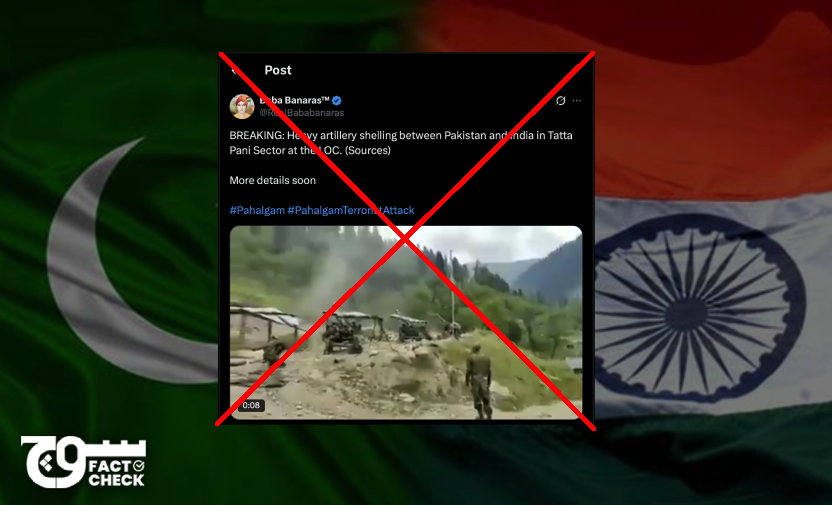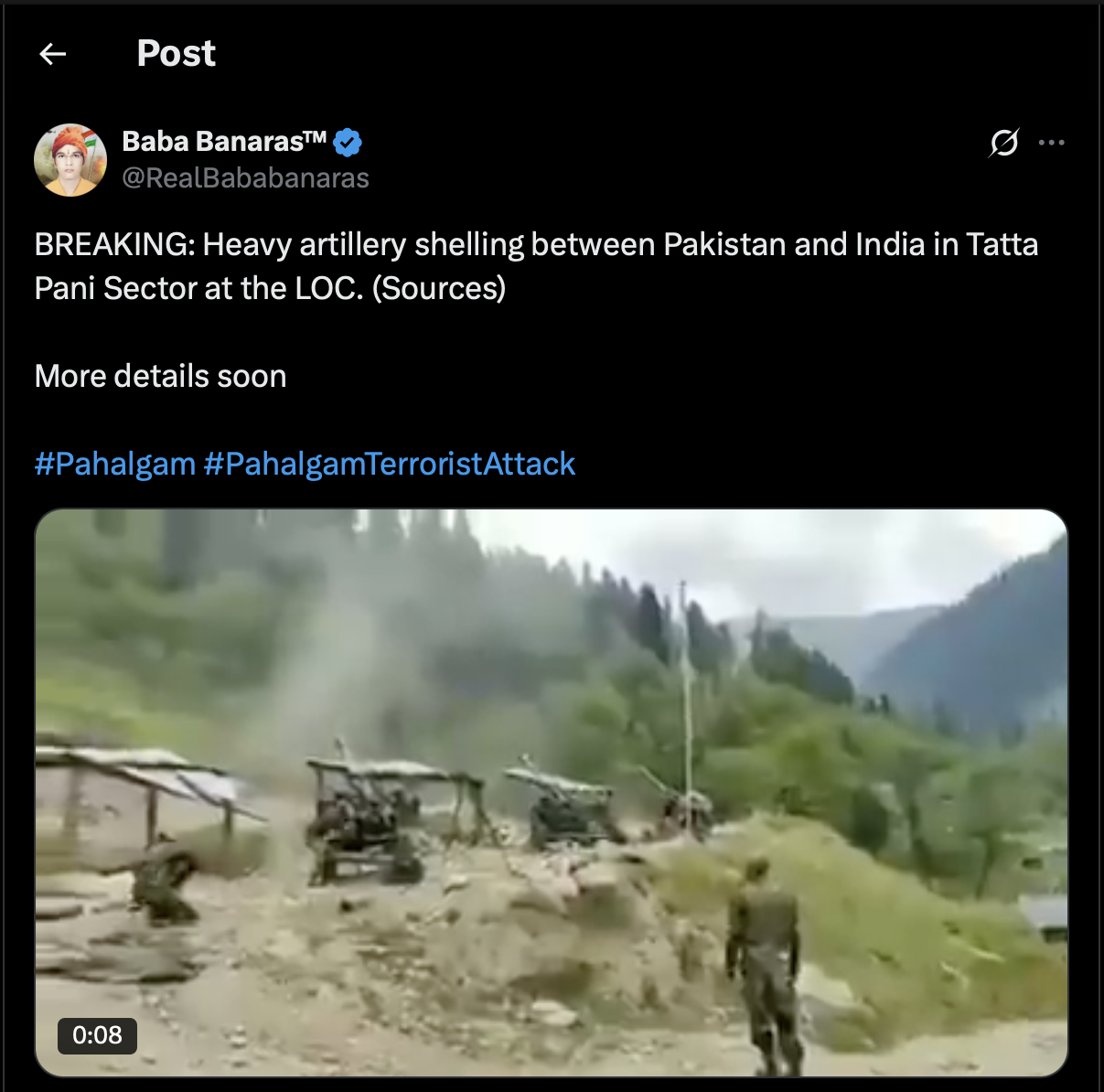
Claim: A video showing heavy artillery exchange between India and Pakistan, in the Tatta Pani sector along the Line of Control (LoC), has emerged online. The skirmish was reported amid the rise in diplomatic tensions between the two countries, following the militant attack on tourists in Pahalgam, in Indian-administered Jammu and Kashmir.
Fact: The video surfaced online at least five years ago and is unrelated to the ongoing tensions between India and Pakistan following the attack in Pahalgam.
On 23 April, an X user posted a video (archive) allegedly showing an exchange of artillery fire between India and Pakistan following a deadly militant attack that killed at least 26 tourists in Indian-controlled Kashmir. The post can be seen below:

The armies of India and Pakistan stationed along the border have reportedly exchanged fire in the past few weeks along the Line of Control (LoC), a 450-mile military line “slicing the disputed Indian and Pakistani governed parts of Kashmir into two.”
Two days after the attack, international publications reported that Pakistan and India exchanged fire along the LoC. According to Indian officials quoted by Al Jazeera and the Associated Press, the Pakistani side initiated firing along the border. The exchange continued for the fourth day, Reuters reported on 28 April.
Therefore, this article only aims to investigate the video shared in the claim.
Militants attack tourists in Pahalgam, India
Gunmen killed at least 26 people at a resort in Pahalgam, in Indian-administered Jammu and Kashmir on 22 April.
The attack took place in the Baisaran Valley, a popular tourist destination, 5km from the resort town of Pahalgam.
The Resistance Front (TRF), up till now an obscure armed group, claimed responsibility for the attack. However, Soch Fact Check has not been able to independently verify the authenticity of this claim. TRF is a proxy group of the Pakistan-based militant group Lashkar-e-Taiba (LeT), according to the Indian officials quoted by The New York Times (archive) and mentioned by Al Jazeera.
Following the attack, the Indian government blamed Pakistan for the massacre. This allegation is part of a wider pattern of India accusing Pakistan of fostering and supporting militants behind attacks like the one in Pahalgam. In 2019, India blamed Pakistan for a deadly suicide bombing that killed 40 Indian soldiers in the Pulwama district of Indian-administered Kashmir.
Soon after, India downgraded its diplomatic relations with Pakistan by expelling the latter’s military advisers from the country’s New Delhi mission and closing a key land border crossing. In a major move, it suspended the Indus Waters Treaty (IWT), a water-sharing agreement brokered by the World Bank in the 1960s that governs the sharing of the Indus River system, a lifeline for Pakistani agriculture.
The Indian government also cancelled the visa exemption scheme for Pakistanis, preventing them from entering the country, and Pakistani nationals in India under this scheme were required to leave within 48 hours of the announcement. Furthermore, the country also announced reducing its diplomatic staff in Pakistan as a retaliatory measure.
According to the NYT, Pakistan has “struck a measured tone” in response to India’s retaliatory measures. At a meeting of the National Security Council (NSC), Pakistan’s top security body on 24 April, Pakistan decided to suspend trade with its neighbour, cancel the visa scheme for Indian nationals, and “announced the closure of its airspace to all India-owned or Indian-operated airlines with immediate effect.” NSC further warned that “any Indian attempt to stop or divert flow of water under Indus Waters Treaty would be ‘act of war’.”
On 26 April, Prime Minister Shehbaz Sharif said Pakistan was “open to participating in any neutral, transparent and credible investigation” into the terror attack.Fact or Fiction?
A reverse-search of the video’s keyframes revealed that it is old. The footage appears to have surfaced as early as 2020.
In September 2020, Factly debunked this footage (archive) when it circulated online, claiming to show ceasefire violations at the India-China border. The article, titled “Old videos being reshared in the light of the latest standoff between Indian and Chinese soldiers,” traced it back to a Facebook video uploaded on the page called “IAF Garud” (which has since been deleted) in April 2020. At the time, the article found that the footage predated the skirmishes between Indian and Chinese forces which reportedly took place in August 2020. This confirms that the video in the claim is not recent.
Republic Bharat, an Indian news channel, reported on a similar video in June 2020. Though it was shot from a different angle, the scenes from this video match the footage in the claim. This further confirmed that the video being fact-checked predates the Pahalgam attack and the ongoing tensions between India and Pakistan.
Finally, a reverse-search also yielded an exact match of the footage from the claim, a Facebook video published by the user “Indian Army Group” in May 2021, another confirmation that it is not connected to the ongoing tensions between India and Pakistan.
Therefore, the footage shared by users after the Pahalgam attack is entirely unrelated to current tensions between Pakistan and India.
Virality
The X post racked up 465,400 views and was liked 4,900 times.
It appeared on X here, here, here, here, here, and here.
On YouTube, the video was posted here, here, and here.
Conclusion: The video does not depict an exchange of fire between India and Pakistan in the wake of the militant attack in Pahalgam, in Indian-controlled Kashmir. It surfaced online at least five years ago and is unrelated to the recent rise in tensions between the neighbouring countries.
Background image in cover photo: Daily Times
To appeal against our fact-check, please send an email to appeals@sochfactcheck.com
